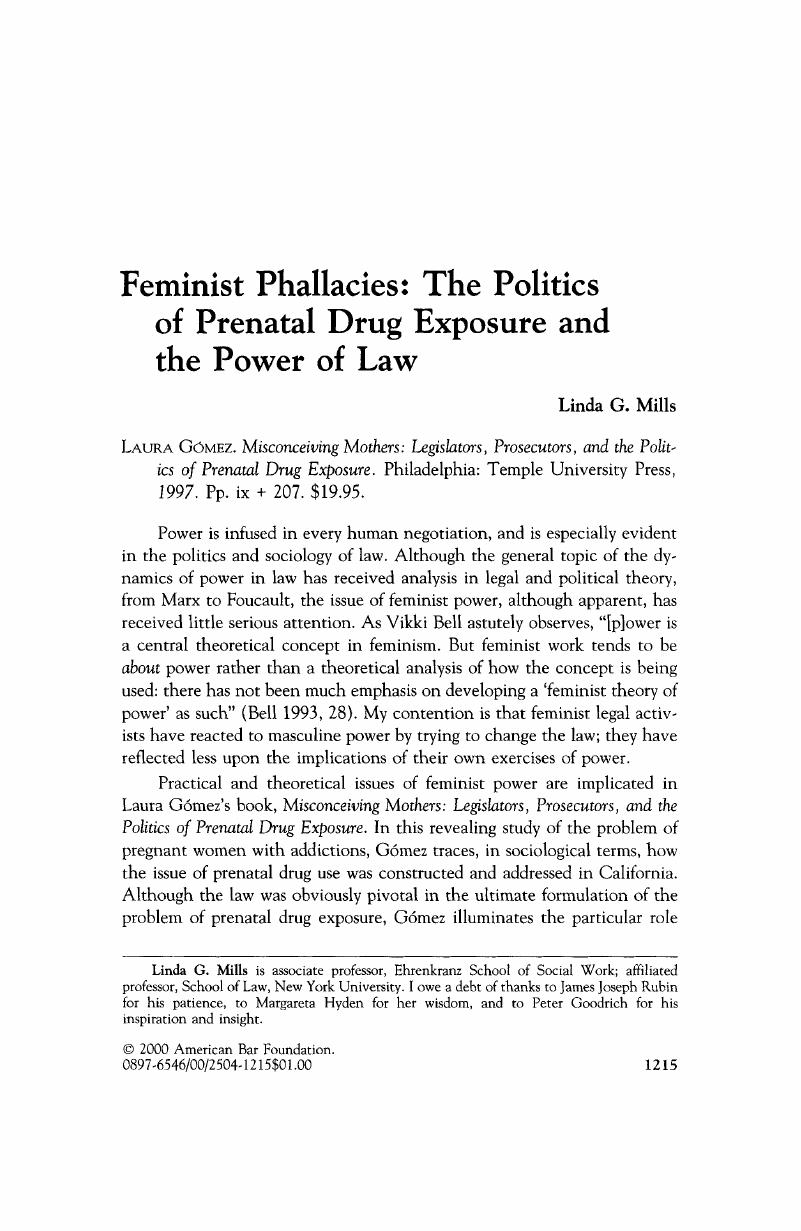No CrossRef data available.
Article contents
Feminist Phallacies: The Politics of Prenatal Drug Exposure and the Power of Law
Published online by Cambridge University Press: 27 December 2018
Abstract
An abstract is not available for this content so a preview has been provided. Please use the Get access link above for information on how to access this content.

- Type
- Review Essay
- Information
- Copyright
- Copyright © American Bar Foundation, 2000
References
Bell, Vikki.
1993. Interrogating Incest: Feminism, Foucault and the Law. London: Rout-ledge Press.Google Scholar
Cleaver, Kathleen N.
1997. Racism, Civil Rights, and Feminism. In Critical Race Feminism, ed. Win, A. K.
New York: New York University Press.Google Scholar
Collins, Patricia Hill.
1991. Block Feminist Thought: Knowledge, Consciousness, and the Politics of Empowerment. New York: Routledge.Google Scholar
Crenshaw, Kimberlé.
1991. Mapping the Margins: Intersectionality, Identity Politics, and Violence Against Women of Color. Stanford Law Review
43:1241–99.Google Scholar
Flax, Jane.
1990. Thinking Fragments: Psychoanalysis, Feminism and Postmodernism in the Contemporary West. Berkeley and Los Angeles: University of California Press.Google Scholar
Foucault, Michel.
1990. The History of Sexuality: An Introduction. Vol. 1. New York: Vintage Books.Google Scholar
Goodrich, Peter.
1997. Epistolary Justice: The Love Letter as Law. Yale Journal of Law and the Humanities
9:245.Google Scholar
Griffith, Dan R., Azuma, Scott, Chasnoff, Ira J.
1994. Three-Year Outcome of Children Exposed Prenatally to Drugs. Journal of the American Academy of Child and Adolescent Psychiatry
33:20–34.Google Scholar
Harris, Angela P.
1990. Race and Essentialism in Feminist Legal Theory. Stanford Law Review
42:581–616.Google Scholar
Hurt, Hallum, Brodsky, Nancy L., Betancourt, Laura, Braitman, Leonard E., Malmud, Elsa, Giannetta, Joan. 1995. Cocaine-Exposed Children: Follow-up through Thirty Months. Developmental and Behavioral Pediatrics
16:29–35.Google Scholar
Irigaray, Luce.
1996. I Love to You: Sketch of a Possible Felicity in History. New York: Routledge.Google Scholar
Karen, G., et al.
1989. Bias Against the Null Hypothesis: The Reproductive Hazards of Cocaine. Lancet, 16 December, 1440–42.Google Scholar
Martin, Beverly.
1988. Feminism, Criticism, and Foucault. In Feminism and Foucault: Reflections on Resistance, ed. Diamond, I. and Quinby, L.
Boston: Northeastern University Press.Google Scholar
Mills, Linda G.
1996a. On the Other Side of Silence: Affective Lawyering for Intimate Abuse. Cornell Law Review
86:1225–63.Google Scholar
Mills, Linda G.
1996b. Battered Women Need Better; Most Victims Still Choose Silence over Prosecution That Is Harsher Than Necessary, Often with Dire Consequences. Los Angeles Times, 28 January 1996, M5.Google Scholar
Mills, Linda G.
1998. The Heart of Intimate Abuse: New Interventions for Child Welfare, Criminal Justice, and Health Settings. New York: Springer Publishing Co.Google Scholar
Mills, Linda G.
1999. Killing Her Softly: Intimate Abuse and the Violence of State Interventions. Harvard Law Review
113:550–613.Google Scholar
Roudinesco, Elisabeth.
1990. Jacques Lacan and Co.: A History of Psychoanalysis in France, 1925–1985. Chicago: University of Chicago Press.Google Scholar




